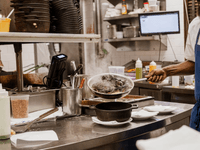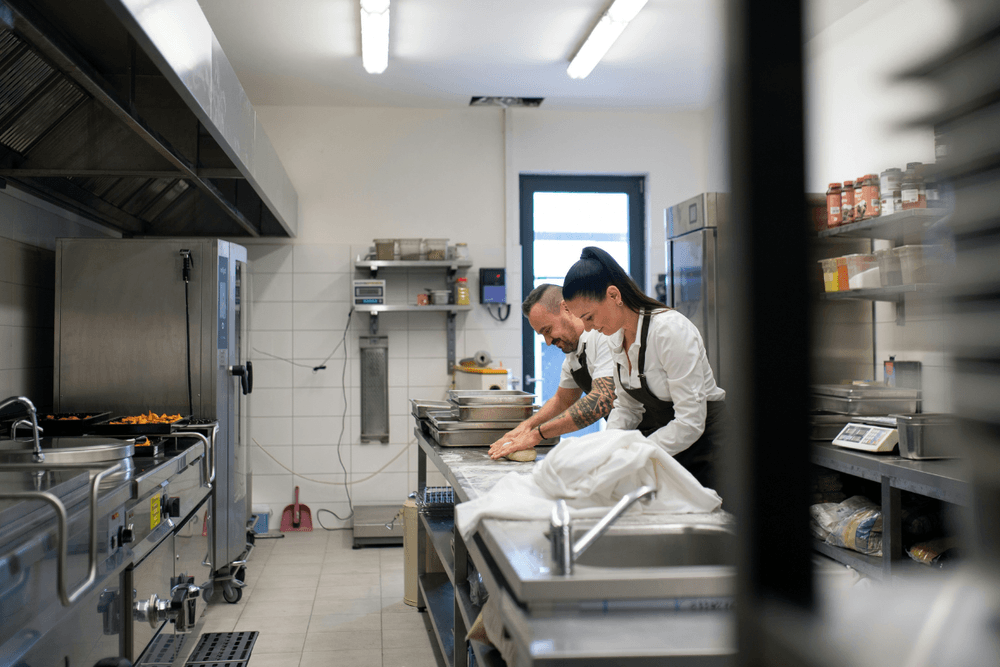Commercial Space with a Kitchen for Rent: What Food Businesses Should Know
Table of Contents
CloudKitchens
How many tacos can be delivered from a 1000sqft restaurant?
The same amount as a 200sqft ghost kitchen.
Key considerations, costs, and benefits of leasing a commercial kitchen space for growing food operations.
For food entrepreneurs, choosing the ideal commercial kitchen is a key step to succeed in the competitive delivery market. A well-structured and health-compliant environment allows large-scale food production, maintains product quality, and meets customer demand efficiently.
A ready-to-use kitchen space offers more than just a place to prepare meals. These facilities provide professional infrastructure with industrial equipment, refrigerated storage, and layouts designed for streamlined and organized operations. These features are essential for businesses aiming to grow and build customer loyalty.
Moreover, various types of commercial kitchens exist, each tailored to meet specific needs. Understanding these options helps operators choose the best kitchen space model that aligns with their growth strategy.
Read More: Commercial kitchens vs. traditional restaurants: which delivers the best ROI?
Understanding Commercial Spaces with Kitchens for Food Businesses
commercial space with a kitchen is a professional facility designed for scaled food preparation. It is essential for businesses focused on delivery because it facilitates productivity, food safety, and regulatory compliance.
Unlike residential or makeshift kitchens, these spaces have industrial-grade equipment, storage areas, and operational flows designed for high volume. This setup allows brands to scale efficiently and consistently fulfill orders.
There are several commercial kitchen models that cater to different types of businesses. Below are the main formats used by delivery and food service operators.
Ghost Kitchens
Ghost kitchens are spaces designed exclusively for preparing and delivering orders. They do not have dining areas or on-site customer service, which reduces fixed costs and optimizes delivery operations.
The ghost kitchen benefits include rapid scalability, the ability to test new markets, and managing multiple brands under one roof. Companies like CloudKitchens offer this type of fully operational kitchen solution, providing entrepreneurs with quick market entry.
Commissary Kitchens
Commissary kitchens are licensed facilities shared among different food operators. They are common among food trucks, small producers, and businesses without their own dedicated space.
These kitchens offer shift-based access and professional infrastructure, and provide an economical alternative for those just starting out. They often include storage areas, prep zones, and industrial equipment.
Incubator kitchens
Incubator kitchens are commercial spaces combined with programs that support food entrepreneurs. Besides infrastructure, they offer mentorship, workshops, and assistance with business formalization.
This model is ideal for those who want to test a concept, develop a product, and gain operational experience with specialized support. Incubator kitchens are often part of social impact projects and local development initiatives.
Mobile kitchens
Mobile kitchens are transportable units such as food trucks or trailers equipped with professional kitchen equipment. They offer geographic flexibility and require a lower initial investment compared to a fixed location.
This type of kitchen is useful for events, market testing, and operations in high-traffic areas. However, it requires special attention to local regulations and supply logistics.
Customized or hybrid kitchens
Some operators choose customized or hybrid kitchens that combine different features. For example, a ghost kitchen with a limited pick-up area or a modular kitchen designed to operate multiple brands.
This model offers flexibility to adapt operations based on demand and business growth. It is a strategic solution for those seeking scalability without losing control of their operations.
Common Challenges When Renting a Commercial Kitchen Space
Renting a commercial kitchen may seem straightforward, but many operators face challenges that delay or compromise their business. Some of the main obstacles include:
Many properties require renovations to meet health and operational standards for commercial kitchens. Structural work, gas, exhaust, plumbing, and electrical installations can take months and significantly increase upfront investment.
Complex licensing processes
Obtaining the necessary permits is often not quick or intuitive. Each municipality may have its own requirements for health inspections, fire department approvals, permits, and technical certifications, requiring time, patience, and professional support.
Hidden costs and unexpected expenses
Even with a defined lease contract, many entrepreneurs face unforeseen costs. Service connection fees, specialized kitchen equipment purchases, mandatory insurance, extra modifications, and last-minute demands can upset the budget.
Infrastructure limitations
Some properties do not provide the infrastructure needed to support modern delivery operations. Poorly arranged spaces, inadequate ventilation, lack of refrigerated storage, and restrictions on industrial equipment use are common issues.
Logistical obstacles
The location of the property can directly affect operational performance. Remote addresses, difficult access for couriers, and lack of space for pickups or parking impact delivery times and customer experience.
Read More: How CloudKitchens helps brands expand into new delivery markets in America
Essential Features to Look for in a Commercial Space with Kitchen
When searching for a delivery kitchen solution, consider more than just size or rent price. The space’s infrastructure must meet sanitary regulations, ensure efficient food preparation, and allow scaling as the business expands.
Ignoring these aspects can lead to operational problems, rework, and even penalties for non-compliance. Choosing a space with the right features from the start helps speed up launch, optimize processes, and maintain the quality standards customers and authorities demand.
Key features to check before signing onto a kitchen space lease include:
- 24-hour access for operational flexibility
- Commercial liability insurance coverage
- Easy access to refrigeration and freezing systems
- Organized waste disposal and cleaning areas
- Kitchen layout adaptable to your business needs
- Durable drainage systems for heavy use
- Professional ventilation already installed
- Walls, floors, and counters with sanitary finishes
Location and Accessibility Matter Most
Choosing the right commercial kitchen location near high-demand areas is critical for success. Shorter time between preparation and delivery increases customer satisfaction and loyalty.
Well-located kitchens also expand service areas and allow for more orders per hour. A strategic address reduces logistics costs and makes operations more competitive from day one.
Built-In Logistics and Support Services
Facilities offering integrated kitchen logistics support and solutions make daily operations easier. Features such as contactless pickup, centralized order management systems, and on-site support teams minimize errors and enhance efficiency.
These services add value by letting entrepreneurs focus on food preparation and quality. Kitchens like those from CloudKitchens come with these structures included, accelerating business success.
Benefits of Renting Ready-to-Use Kitchens from CloudKitchens
Building and setting up a kitchen from scratch can take months and consume precious resources in construction, permits, and equipment purchases. For food delivery businesses needing to enter the market quickly, these delays represent lost opportunities and added costs.
With CloudKitchens, you can start operations with a low initial investment, significantly lower than traditional commercial leases. The kitchens come ready to use, letting operators begin producing and selling potentially within weeks, not months.
Here are the main benefits of CloudKitchens’ ready-to-use kitchens:
- Licensed kitchens operational from day one
- Market entry with reduced upfront investment
- No construction, technical installations, or equipment expenses
- Flexible contracts that scale with your business growth
- Maintenance and infrastructure support included
- Strategic locations near high delivery demand
*Investment amount may vary depending on kitchen size and region.
How to Choose the Right Commercial Space with Kitchen for Your Business
Choosing the right kitchen is a strategic decision that can either drive or limit your delivery business growth. The key is to match your current needs with growth potential, always evaluating infrastructure, location, and available support. Here are some top tips to help you decide:
- Prioritize a strategic location: choose a kitchen close to major demand centers to reduce delivery times. This directly impacts customer satisfaction.
- Check the facilities provided: ensure the space has the right equipment, storage, and infrastructure for your operation. Well-equipped facilities boost efficiency.
- Visit the space in person: inspect the infrastructure and test how everything works. A personal visit helps avoid surprises after signing an agreement.
- Evaluate security and access controls: look for entry management, surveillance cameras, and 24-hour access. These features provide flexibility and ensure safety.
- Review contract terms carefully: understand contract duration, costs, adjustments, and termination conditions. Flexible agreements support business growth and prevent unexpected issues.
- Understand your business stage: assess your current production volume and menu type. Select a kitchen that fits your operational routine and growth goals.
- Seek recommendations and reviews: talk to other users and read reviews to learn about the location’s reputation. Feedback from others can inform your decisions.
- Confirm hygiene standards: ensure the kitchen complies with regulations and maintains a clean, organized environment. This reduces the likelihood of fines or food safety issues.
- Consider space availability: check usage hours, possibilities for expansion, and logistics planning to avoid conflicts. Good organization is key for smooth operations.
Explore Commercial Kitchens with CloudKitchens
If you want to accelerate your delivery business growth, now is the time to act. Visit CloudKitchens’ locations page to explore ready-to-use commercial spaces in strategic locations.
Connect with an expert to answer your questions and get personalized guidance. Then schedule a visit to see firsthand the infrastructure, technology, and support that can boost your operation.
With CloudKitchens, you will find the ideal space to expand your business quickly, safely, and efficiently. Don’t wait; take advantage of this opportunity to turn your kitchen into a successful delivery hub.
FAQ – Renting a Commercial Space with a Kitchen
What key factors should I consider before renting or licensing a commercial kitchen space?
Look at location, kitchen size, equipment quality, contract terms, compliance with health codes, and accessibility for deliveries.
How can I verify that the kitchen meets all regulatory requirements?
Request proof of licenses and inspections, check local health department records, and ensure the space follows food safety standards.
Are there other costs that I should be aware of before renting or licensing a commercial kitchen?
Yes, be aware of utilities, cleaning fees, maintenance charges, insurance, and potential costs related to shared kitchen usage or scheduling conflicts.
DISCLAIMER: This information is provided for general informational purposes only and the content does not constitute an endorsement. CloudKitchens does not warrant the accuracy or completeness of any information, text, images/graphics, links, or other content contained within the blog content. We recommend that you consult with financial, legal, and business professionals for advice specific to your situation.
More insights & stories
There’s more where that came from.
Get in the know and check out our additional insights




